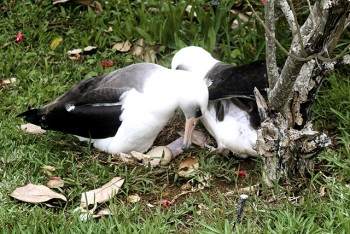Scott Shaffer (Department of Biological Sciences, San José State University, San Jose, California, USA) and colleagues write in the open-access electronic journal PLoS ONE use miniature loggers in artificial eggs to investigate egg-turning in Laysan Albatrosses Phoebastria immutabilis and two other seabird species.
The paper’s abstract follows:
“Egg turning is unique to birds and critical for embryonic development in most avian species. Technology that can measure changes in egg orientation and temperature at fine temporal scales (1 Hz) was neither readily available nor small enough to fit into artificial eggs until recently. Here we show the utility of novel miniature data loggers equipped with 3-axis (i.e., triaxial) accelerometers, magnetometers, and a temperature thermistor to study egg turning behavior in free-ranging birds. Artificial eggs containing egg loggers were deployed in the nests of three seabird species for 1–7 days of continuous monitoring. These species (1) turned their eggs more frequently (up to 6.5 turns h−1) than previously reported for other species, but angular changes were often small (1–10° most common), (2) displayed similar mean turning rates (ca. 2 turns h−1) despite major differences in reproductive ecology, and (3) demonstrated distinct diurnal cycling in egg temperatures that varied between 1.4 and 2.4°C. These novel egg loggers revealed high-resolution, three-dimensional egg turning behavior heretofore never measured in wild birds. This new form of biotechnology has broad applicability for addressing fundamental questions in avian breeding ecology, life history, and development, and can be used as a tool to monitor birds that are sensitive to disturbance while breeding.”

A Laysan Albatross pair changes over incubation duties
Photograph by Bob Waid
Reference:
Shaffer, S.A., Clatterbuck, C.A., Kelsey, E.C., Naiman, A.D., Young, L.C., Vanderwerf, E.A., Warzybok, P., Bradley, R., Jahncke, J. & Bower, G.C. 2014. As the egg turns: monitoring egg attendance behavior in wild birds using novel data logging technology. PLoS ONE 9(6): e97898. doi:10.1371/journal.pone.0097898.
John Cooper, ACAP Information Officer, 10 June 2014

 English
English  Français
Français  Español
Español